 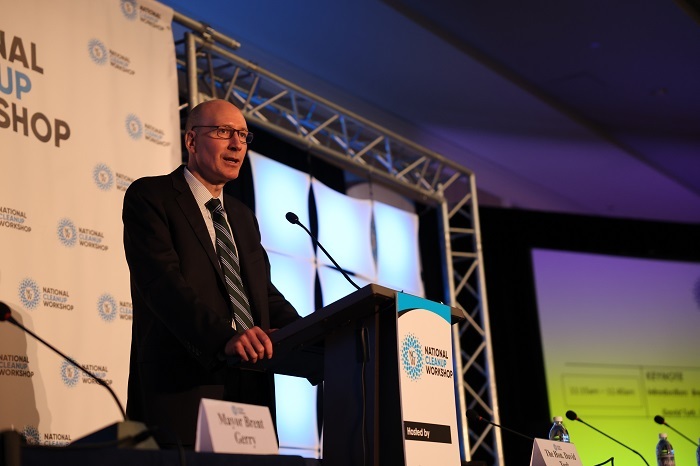 In his keynote address at the 2023 National Cleanup Workshop on Tuesday, Sept. 12, Deputy Energy Secretary David Turk highlighted EM successes, the Department's Cleanup to Clean Energy initiative and workforce development, among other topics.
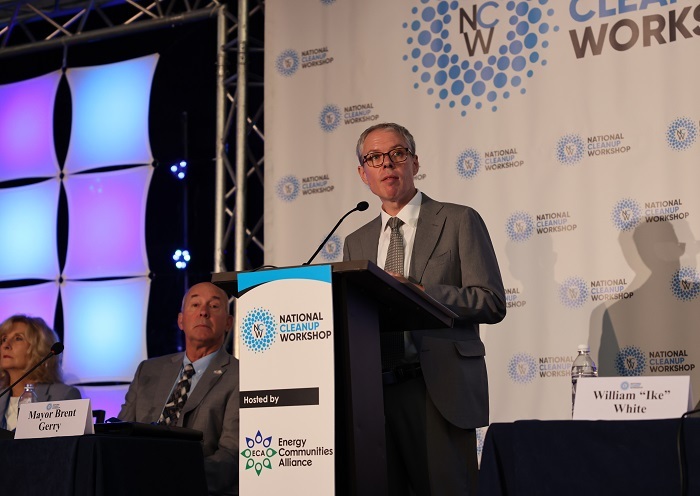 EM Senior Advisor William "Ike" White speaks about EM's progress and priorities at the start of the 2023 National Cleanup Workshop. "The level of progress that we're seeing is clear across the country," White said. "We're on track again to complete the vast majority of our annual priorities."
U.S. Deputy Energy Secretary David Turk and EM Senior Advisor William "Ike" White gave remarks today at the start of the 2023 National Cleanup Workshop, which saw a record turnout of attendees.
Hosted by the Energy Communities Alliance with the cooperation of EM and the Energy Facility Contractors Group, the event is a premier annual gathering to discuss progress in environmental cleanup of former government weapons sites and nuclear research facilities.
In his keynote address, Turk shared EM cleanup successes across the DOE complex, detailed workforce development efforts and highlighted the Department's Cleanup to Clean Energy initiative focused on generating clean energy on DOE-owned lands.
"What we're going to do with this program is take some of the lands that you've remediated that we've been working on for so many years, and for the first time ever, begin leasing them out so that developers, other partners can build some of the largest clean energy projects in the world," Turk said.
White called the workshop an opportunity to discuss the next phase of the cleanup mission.
"In recent years, I think we have reached an inflection point for our EM mission," White said. "We know what waste we have, and we know how to safely treat it. Most of our cleanup capabilities are in place or they're nearly in place, in some cases after decades of planning and construction. We are acting on opportunities to enable continued success."
Read more about the addresses by Turk and White as well as other workshop highlights in next week's EM Update newsletter due out Tuesday, Sept. 19.
 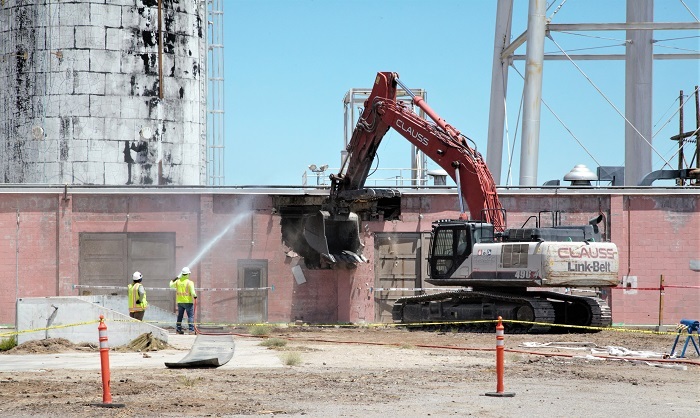 EM crews begin demolition of Building 3220 at Test Cell C at the Nevada National Security Sites in late June.
Cleanup program completes demolition of four Test Cell C buildings
LAS VEGAS – Months of planning came to fruition as EM Nevada Program crews safely completed demolition of four buildings at the Test Cell C (TCC) Facility at Area 25 of the Nevada National Security Sites (NNSS), meeting an EM 2023 priority ahead of schedule.
“This is an important accomplishment for our Industrial Sites team,” said John Wrapp, program manager for Navarro Research and Engineering, the EM Nevada Environmental Program Services contractor. “The completion of our 2023 mission and priorities goals at TCC is the result of significant preparatory work, careful collaboration between management and staff and the hard work of EM Nevada crew members.”
 Both TCC and the Engine Maintenance, Assembly, and Disassembly (EMAD) Facility were part of the now-inactive Nuclear Rocket Development Station, which supported development and testing of nuclear rocket engines from 1957 until 1973.
“In total, 1,975 industrial sites were identified in the Federal Facility Agreement and Consent Order, have been inventoried, and corrective actions planned or completed. Regulatory closure has been achieved at 99% of them,” said Industrial Sites Manager Jason Sofie. “Demolition activities over recent weeks were primarily focused on open-air demolition of four main buildings at Test Cell C.”
Demolition at TCC began with Building 3220, which once housed a series of water pumps and an operations control center. Crew members used excavators with hydraulic shears and hammers to bring down the buildings. Water from hoses was used for dust suppression.
Crew members used excavators to load debris into dump trucks, and radiological control technicians (RCTs) scanned the buckets of each excavator to ensure debris destined for industrial disposal did not contain radionuclides. Waste was transported and disposed of at the NNSS Area 9 U-10c landfill. Prior to transportation, RCTs scanned the truck tires to make sure they did not track radionuclides when they departed TCC.
The other three buildings demolished during the current window of work at TCC each served different roles. One was a generator building that produced electricity, another was a pump room that processed water and the third was a cryogenics building that supported the liquid hydrogen process as rocket engines were tested.
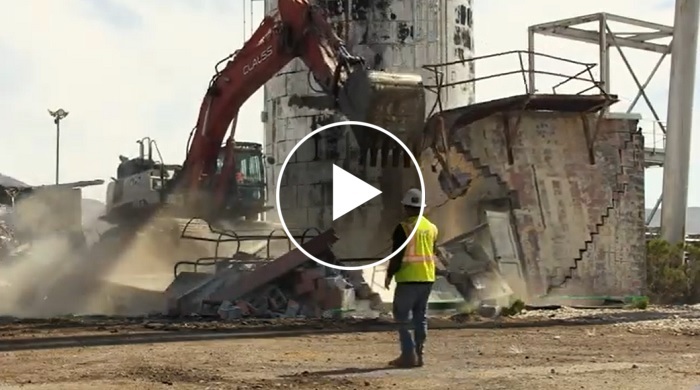 Watch this video about the EM Nevada Program's work to safely complete demolition of four buildings at the Test Cell C Facility at Area 25 of the Nevada National Security Sites.
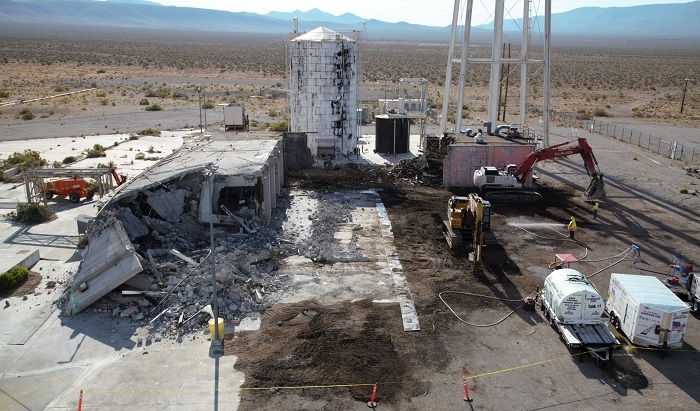 An overhead view of Test Cell C Facility on the second day of Building 3220 demolition.
One of the hurdles at TCC is simply its age.
“The unique challenge is that it’s a legacy site,” Sofie said. “It was operated decades ago in the ‘60s and ‘70s so information is sparse and not completely clear when it comes to drawings and as-left conditions. Systems, structures and components have been there for a long time and have partially degraded, causing potentially unstable conditions, and wildlife occupied the structures we had to address.”
Crews spent months on characterization and hazard-reduction activities at TCC. The abatement work included the removal of hazardous waste and asbestos and allowed crew members to perform “open-air” demolition. The debris transported to the U-10c landfill was industrial waste, meaning it was determined to not contain hazardous chemicals or radiological contamination above the industrial landfill's waste acceptance criteria.
“We started with open-air demolition preparations,” Sofie said. “These preparations included removal of hazardous waste and prohibited items such as lead, asbestos, Freon, oils, greases and lighting ballasts. So, once we got to the point waste operations was satisfied prohibited items were removed, they gave us documented concurrence the buildings were ready for open-air demo.”
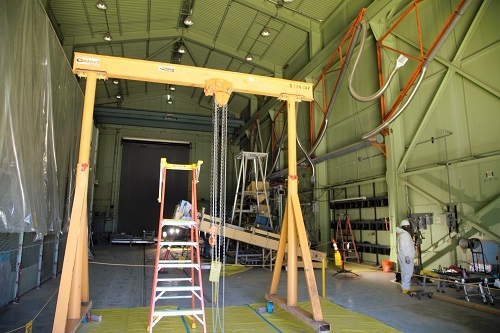 |
|
Crews perform pre-demolition activities at the Engine Maintenance, Assembly, and Disassembly Facility in Building 3901, also known as the Train Shed. |
Crew members performed radiological surveys and underground mapping at both TCC and EMAD prior to initiating demolition work. Learn more about the preparatory work here.
Work now shifts back to the EMAD Facility to begin the demolition of Building 3901, also known as the Train Shed. The end goal at EMAD and TCC is to demolish both facilities down to the concrete slab. With the demolition of the four buildings at TCC recently finished, EM Nevada completed its EM mission and priorities goals for the 2023 calendar year.
-Contributors: Grant Johnson, Kevin Knapp
 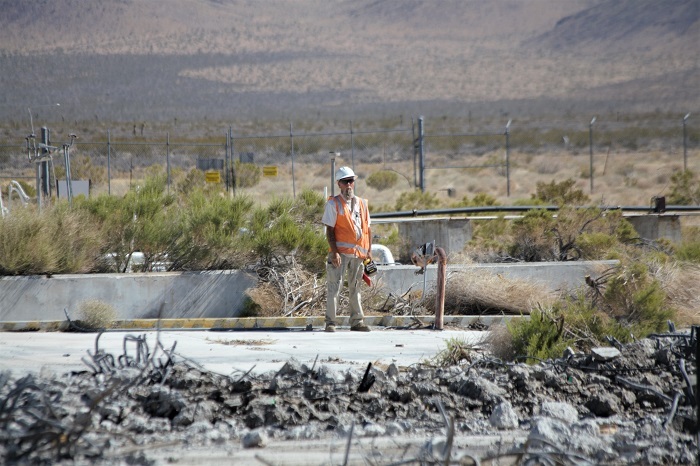 Radiological control technician Bob Moore oversees demolition work at the Test Cell C Facility. On this day it was well over 100 degrees.
LAS VEGAS – Radiological control technicians (RCTs) are integral to cleanup and remediation performed by the EM Nevada Program at the Nevada National Security Sites (NNSS), yet they can go unnoticed in day-to-day operations.
On any given day, an RCT can perform several duties, from routine performance tests of radiation detection instruments to radiation and contamination monitoring, air sampling, posting and labeling, access control, material clearance surveys and radioactive waste surveys. Their duties protect EM employees and their contractors that have contact with radioactive material.
During the recent demolition of four buildings at the Test Cell C (TCC) Facility, which met an EM 2023 priority early, RCTs were busy contributing to the safe and secure work at the legacy site.
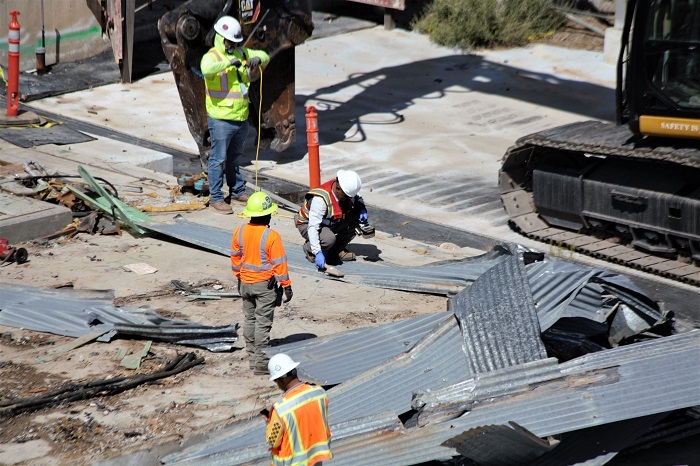 Radiological control technician JC Castro, shown kneeling, checks pieces of roofing after removal from Building 3231 at Test Cell C.
At TCC, crew members used excavators with hydraulic shears and hammers to bring down the buildings. Trucks were loaded with debris, and RCTs scanned the buckets of each excavator to ensure debris destined for industrial disposal did not contain radionuclides.
On a day in early July, EM Nevada RCT Bob Moore held that responsibility. He scanned each excavator bucket with a device that detects both alpha and beta particles and swiped the bucket to test for loose contamination. If any radiation above action levels was detected, work would pause immediately.
“We have to make sure that whatever they’re picking up and putting into the bucket isn’t contaminating the bucket with radioactivity,” said fellow RCT JC Castro.
Castro’s role was to monitor each truck at the gate before leaving TCC. Castro made dose readings of each truck and swiped the tires to further check for radioactive material. He also ensured each truck survey was properly documented.
The waste created during demolition work at TCC was primarily industrial waste, meaning it was determined to not contain hazardous chemicals or radiological contamination above the industrial landfill's waste acceptance criteria.
“It’s industrial waste unless it’s not,” Castro said. “Unless Bob detects something off the bucket, or if I detect something off the dose instrument meter… I also take swipes off the front and back tires because they’re the most likely to pick up contamination. At any one of these surveys, if we find any contamination, we have to stop.
“The procedure is to contact our supervisors, inform them of the situation, inform our Radiological Services Manager Mike Van Der Karr, and then they decide how to proceed,” Castro said.
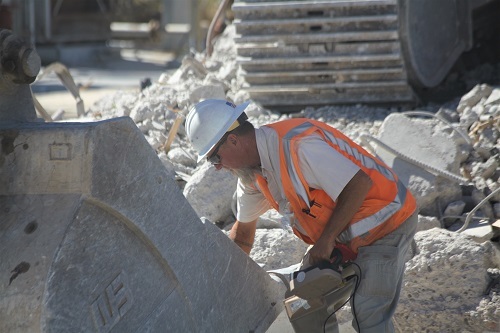 |
|
Radiological control technician Bob Moore sweeps the excavator bucket.
|
Radiological control technician JC Castro works on paperwork while waiting for the next waste transport truck to be surveyed. |
|
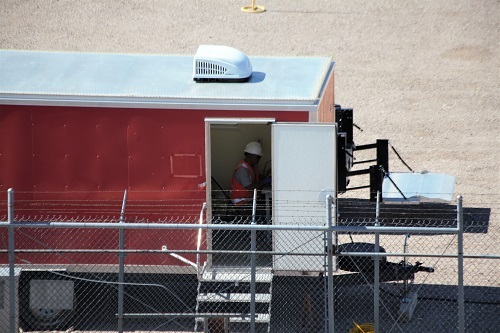 |
Debris deemed industrial waste was transported and disposed of at the NNSS Area 9 U-10c landfill. For Moore, who has worked at the NNSS since 1997, it was just another day on the job.
“Pretty typical. If anything, this was a smaller job.” Moore said of the work at TCC.
But the impact of RCTs at the job site was anything but small.
Months of preparatory work were completed prior to a single construction vehicle entering TCC. RCTs were present through it all. While crews spent months on characterization and hazard-reduction activities at TCC, RCTs were present. When abatement work was being done, which included the removal of hazardous waste and asbestos and allowed crew members to perform “open air” demolition, RCTs were there every step of the way. These preparatory measures ensured the majority of waste was industrial waste, and the diligent work of RCTs supported worker safety throughout the entire demolition process.
“RCTs are essential to the EM Nevada mission — and a significant reason the demolition of four buildings at TCC was completed safely, securely and successfully,” said Radiological Services Manager Mike Van Der Karr.
-Contributors: Grant Johnson, Kevin Knapp
 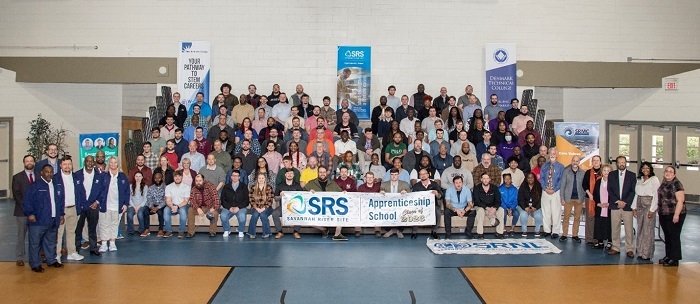 The first joint cohort of Savannah River Site production operator apprentices at Aiken Technical College.
Over 100 apprentices across three Savannah River Site contractors
AIKEN, S.C. – The first joint cohort of Savannah River Site (SRS) production operator apprentices recently graduated from Aiken Technical College’s Nuclear Fundamentals Program, marking the first time three SRS contractors jointly participated in the program.
The Production Operator Apprentice Program started as a partnership with SRS managing and operating contractor Savannah River Nuclear Solutions (SRNS), Aiken Technical College, Apprenticeship Carolina, and the Lower Savannah Council of Governments. In the eight-month program, students spend two days a week in the classroom and two days a week performing on-the-job training at SRS. At the end of the program, participants earn a certificate in nuclear fundamentals.
“The apprenticeship program is a great model showing the impact of linking education and industry,” said Aiken Technical College President Forest E. Mahan. “Participants can earn a college credential, receive on-the-job training, network and be mentored throughout the program. It is a formula that prepares our students for success and continued career advancement for years to come.”
For this round of operator apprentices, SRNS joined with Savannah River Mission Completion (SRMC), the liquid waste contractor at SRS, and EM’s Savannah River National Laboratory (SRNL) to offer over 100 openings for the program. Battelle Savannah River Alliance is the managing and operating contractor for SRNL.
The apprentices learned the basic qualifications of a production operator, including conduct of operations principles, radiation worker training and qualification, and how to perform shift rounds. Those who successfully completed the program were hired and put to work in areas across SRS.
A ceremony was held last month to honor the more than 100 program graduates. Representatives of Aiken Tech College and each of the three SRS contractors involved gave opening remarks. Special guest speakers included DOE-Savannah River Deputy Manager Edwin DeShong and South Carolina Rep. Bart Blackwell, along with three program graduates.
SRNS Production Operator Apprentice Terrence Tillman was one of the three students who spoke at the ceremony.
“This is going to change my lifestyle. I will have more time to do things with my family,” he said. “Knowing what the job entails and what its purpose is, I feel like I'm helping the country and the community.”
SRMC received the largest class of operators in its history with 51 new hires set to fill key roles in various SRS liquid waste facilities. Forty-six of the graduates will go to work for SRNS and five were hired by SRNL.
“We are thrilled to have our newly trained class of operators, the largest in our recent hiring history, join Savannah River Mission Completion full time,” SRMC President and Program Manager Dave Olson said. “Production operators play a key role in the safe and efficient operations of our nuclear facilities and will be a tremendous asset as we continue our mission to safely reduce the risk to the community and the environment of radioactive liquid waste stored at SRS.”
SRNS is also welcoming its largest production operator apprentice cohort to date.
“At this moment, the eyes of the country truly are on the Savannah River Site as we continue to execute our vital national security and cleanup missions,” said SRNS President and CEO Dennis Carr. “Outside of the contributions that our apprentices will inevitably make in making the world safer, they can be also proud of the large impact their work at SRS will have in the community.”
Booboo Roberts, SRNS program manager for apprenticeship and pipeline training, noted that SRNS currently has 22 apprenticeship programs.
“It’s an honor to be a part of helping our company prepare for the future and to help our students reach a better quality of life,” Roberts said.
-Contributor: Lindsey MonBarren
 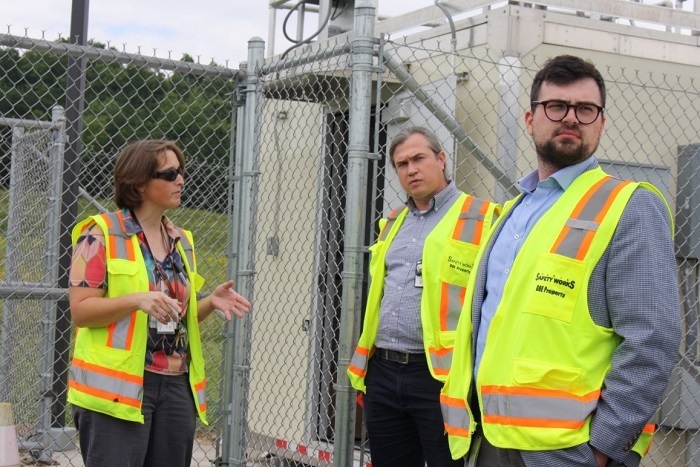 Environmental Science Supervisor Danielle Stumbo, left, explains air monitors used at the Portsmouth Site to members of Sen. Sherrod Brown’s staff.
PIKE COUNTY, Ohio – Members of Congress and their staff, DOE officials and others visited EM’s Portsmouth Site in recent weeks where they received updates on future use plans for the site as well as decontamination and decommissioning (D&D) progress.
“We are always happy to host visitors to our site,” said Portsmouth Site Lead Jeremy Davis. “There is no better way to understand the Portsmouth Site than a firsthand look at what is taking place.”
As part of their visit, representatives from the office of Sen. Sherrod Brown of Ohio viewed air monitoring systems used throughout the site.
“Not only do we have our own monitoring systems across the site, but also co-located monitors owned and operated by the Ohio Environmental Protection Agency to offer verification of the data obtained,” Environmental Science Supervisor Danielle Stumbo said.
Days later, Reps. Brad Wenstrup and Troy Balderson visited the Portsmouth Site to view cleanup progress and understand more about the site’s future use plans.
“I am extremely impressed with what you are doing here,” Wenstrup said during the tour. “It is amazing to see how much you have done since the last time I was here.”
 EM Portsmouth Site Federal Project Director Jud Lilly, center, explains the D&D process used for the former X 326 Process Building to Reps. Troy Balderson, left, and Brad Wenstrup.
 Staff members from the DOE Office of the Inspector General gather at a lookout area to view the On-Site Waste Disposal Facility at the Portsmouth Site.
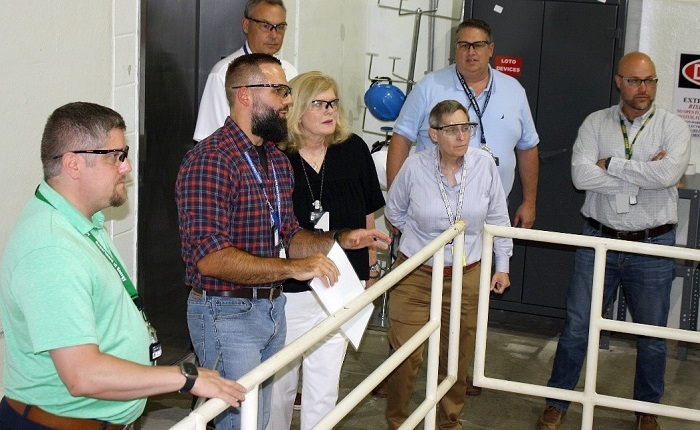 DUF6 Program Manager Zak Lafontaine, second from left, gives a tour of the Portsmouth Site DUF6 facility. Also pictured, from left, are Information Technology Cybersecurity Specialist Will Welch, EM Portsmouth/Paducah Project Office (PPPO) Manager Joel Bradburne, EM Chief Information Officer Jeanne Beard, DOE Chief Information Officer Ann Dunkin, PPPO Deputy Manager Reinhard Knerr and Portsmouth Site Lead Jeremy Davis.
In a separate visit, a large group from the DOE Office of the Inspector General with interest in future use of the plant listened to a site overview from Davis. He also conducted a tour showing parcels transferred for reuse.
“We have received a lot of interest to build new facilities here,” said Davis. “Our end goal is to be able to offer reindustrialization opportunities for the community once D&D is complete at the Portsmouth Site.”
DOE Chief Information Officer Ann Dunkin and EM Chief Information Officer Jeanne Beard visited the Portsmouth Site and Depleted Uranium Hexafluoride (DUF6) Conversion Project. Topics of discussions included current operations of the DUF6 Program and D&D at the Portsmouth Site.
-Contributors: Shawn Jordan, Michelle Teeters
  Oak Ridge Office of Environmental Management Manager Jay Mullis speaks to union construction crews, thanking them for their work on a project critical to future cleanup at the Y-12 National Security Complex. The frame of the new treatment plant for the Outfall Mercury Treatment Facility is visible in the background.
OAK RIDGE, Tenn. – The Oak Ridge Office of Environmental Management (OREM) has established a new workforce retention incentive that rewards the union construction team for progress as it builds the Outfall 200 Mercury Treatment Facility.
OREM Manager Jay Mullis and national labor union leaders recently met with the workforce at the construction site to announce the new program.
“This is our way of thanking you for your work to keep this critical project moving forward,” said Mullis. “The facility you’re working on enables us to ramp up major cleanup that will transform Y-12.”
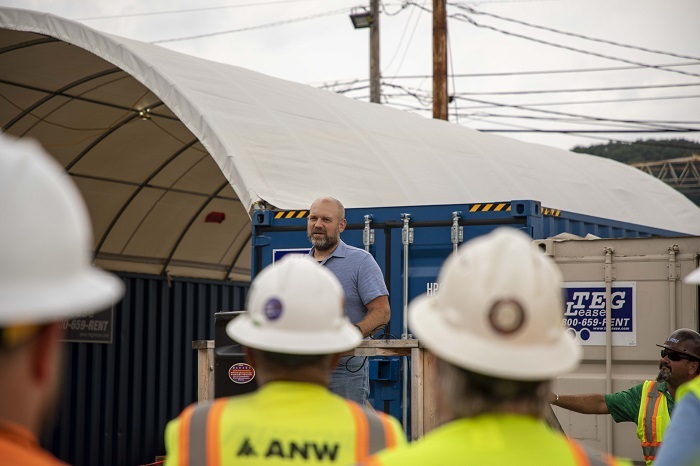 North America’s Building Trades Unions Field Services Director Kevin Adkisson addresses construction crews building the Outfall 200 Mercury Treatment Facility at Oak Ridge.
The facility is an essential infrastructure project that makes it possible for OREM to begin addressing some of the greatest environmental risks at the Y-12 National Security Complex. It allows crews to start demolishing massive Manhattan Project-era buildings contaminated with mercury and address the soil beneath them.
“I’m grateful that DOE is recognizing this hardworking construction team, especially for their progress in such a tight and challenging footprint,” North America’s Building Trades Unions Field Services Director Kevin Adkisson told the workers. “I started my construction career here at the now-demolished K-25 plant, and it’s great to see your progress on this next chapter of the Oak Ridge cleanup program.”
 A view of ongoing construction on the headworks facility, one of two facilities that will comprise the Outfall Mercury Treatment Facility at Oak Ridge.
The mercury treatment facility is comprised of two components at two locations — a headworks facility and a treatment plant — connected by a pipeline more than half a mile long.
The headworks facility will capture creek flow, store excess stormwater collected during large rainfalls, remove grit, and pump water through the pipeline to the treatment plant. The treated water will then flow back into the creek.
Construction is moving forward on both structures, and the recently announced incentive program ensures momentum continues until the project is finished.
The treatment plant’s structure is underway, and crews are installing a significant amount of concrete and rebar at the headworks plant. The team at the headworks facility has installed 200 tons of rebar and poured 700 cubic yards of concrete.
-Contributor: Ben Williams
 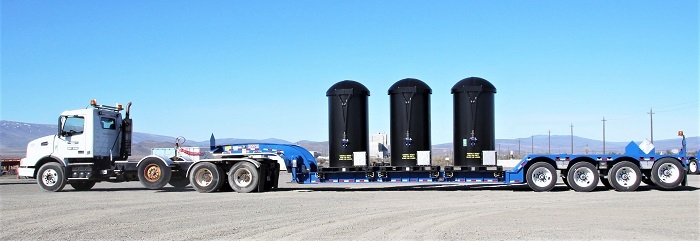 A specially designed truck and trailer will transport containers of non-radioactive test glass from the Hanford Site Waste Treatment and Immobilization Plant to an offsite facility for disposal during a yearlong testing and cold commissioning process.
RICHLAND, Wash. – EM is testing technologies and processes needed to help immobilize Hanford Site tank waste in glass through a process called vitrification. EM Office of River Protection (ORP) contractor Washington River Protection Solutions (WRPS) has a role in transporting non-radioactive glass created during this testing to an offsite facility for disposal.
In August, workers at the Waste Treatment and Immobilization Plant (WTP) began adding the first batches of glass beads, called frit, into a melter heated to 2,100 degrees Fahrenheit in the plant’s Low-Activity Waste Facility. The molten glass will be poured into stainless steel containers. Once cooled, the containers will be loaded into a holder, called a pallet, for transportation.
During this commissioning phase, a specially designed truck and trailer will transport the containers of non-radioactive glass to Chemical Waste Management, Inc., an industrial and hazardous waste landfill in Arlington, Oregon. Eventually, the same truck and trailer will be used to ship the vitrified radioactive waste from WTP to the Integrated Disposal Facility (IDF) on the Hanford Site.
“This is another achievement that brings us a step closer to immobilizing Hanford’s tank waste,” said Delmar Noyes, ORP assistant manager for Tank Farms Project. “This process allows Hanford Site contractors to test their mission readiness and make any adjustments needed to procedures or processes before commissioning of the facility begins.”
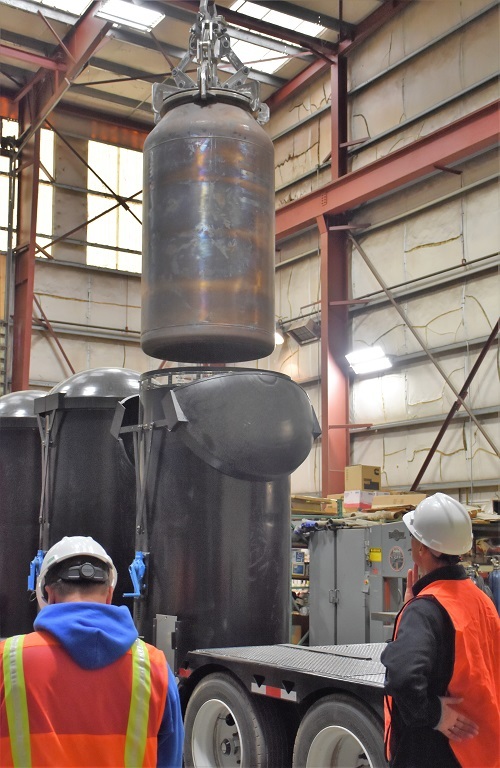 |
|
A waste container filled with non-radioactive test glass will be placed inside a pallet before shipping offsite for safe disposal. |
The transportation process has been tested too, with several practice runs from Hanford to the Oregon landfill — a 125-mile, one-way trip.
“We are ready to go,” said Mark Gerboth, WRPS Mission Integration & Optimization manager. “Dry runs are crucial steps toward the safe and compliant transportation of the test glass for offsite disposal, and eventually, transporting vitrified tank waste for onsite disposal at IDF.”
During the nearly yearlong testing and cold commissioning process, the WTP team will fill more than 350 containers with frit to begin with, and ultimately with tank waste simulants and frit to mimic the process that will be used during actual operations. Shipments to the offsite landfill during cold commissioning will range from once or twice a week, to as often as daily.
-Contributor: Joan Lucas
 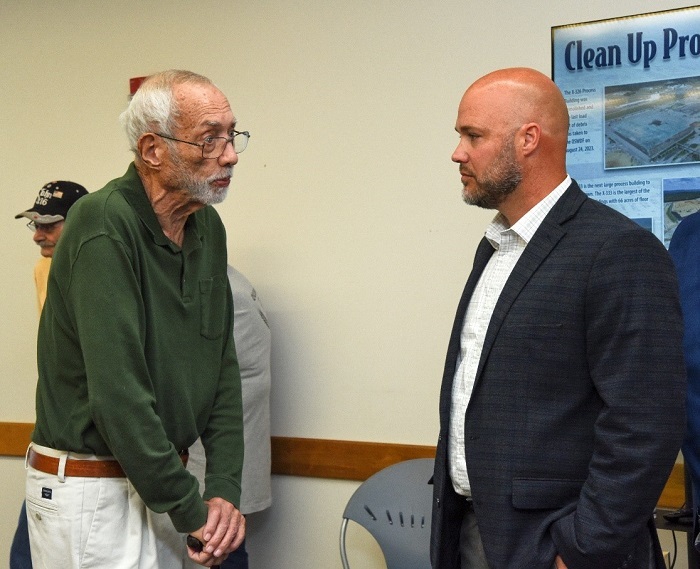 Portsmouth Site Lead Jeremy Davis, right, talks with a community member while providing information on site progress during the Pike County Open House.
PIKE COUNTY, Ohio – Communication is critical to any relationship, and this stands true for the Portsmouth Site and its local community.
Through its open house events, the Portsmouth Site maintains and builds trust within the community by providing communication on decontamination and decommissioning progress. These events allow the public to speak one-on-one with representatives from EM, site contractors and various community-support organizations.
During recent open house sessions in Scioto and Pike counties, community members visited various stations containing photographs and information. They also spoke with individuals from the site, Southern Ohio Diversification Initiative, Portsmouth Site Specific Advisory Board, Ohio University, Ohio Environmental Protection Agency, and Kathryn Higley, Ph.D., an expert in radiological health sciences at Oregon State University.
“In order to maintain and build trust with the community, open and honest communication is important,” said Portsmouth/Paducah Project Office Manager Joel Bradburne. “We have found our series of open house meetings, held twice a year throughout the region, to be a great way for the community to carry on conversations with our subject matter experts at a more personal level.”
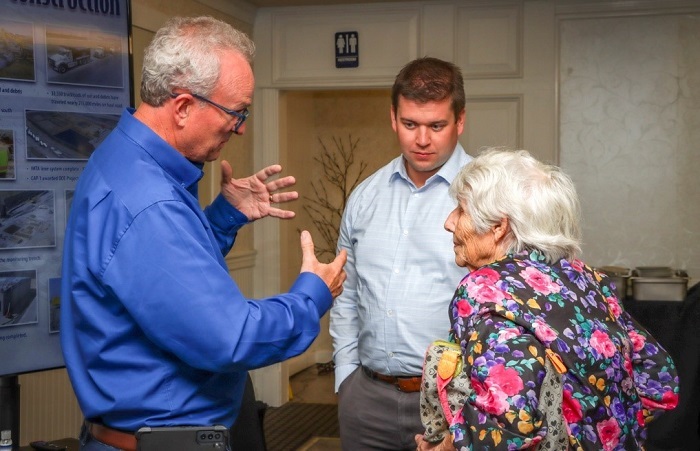 Fluor-BWXT On-Site Waste Disposal Facility Director Paul Larsen, left, speaks to Portsmouth business owner Nancy Ross, right, with input from Enterprise Technical Assistance Services Technical Support Lead Jesse Pack during the Scioto County Open House.
The events allow individuals to ask questions and learn about what the future holds for the site, Portsmouth Site Lead Jeremy Davis added.
“It’s crucial we have these open conversations with the community and stakeholders so they know what comes next,” Davis said. “They can drive by and see the buildings come down. However, there are always questions regarding the end state of the site.”
More than two dozen community members attended the Scioto County open house, and nearly 60 were present at the Pike County event. The events are free and open to the public.
The Portsmouth Site also offers other opportunities for community engagement through monthly public site tours conducted from April to October. Click here for more information.
-Contributors: Shawn Jordan, Michelle Teeters
 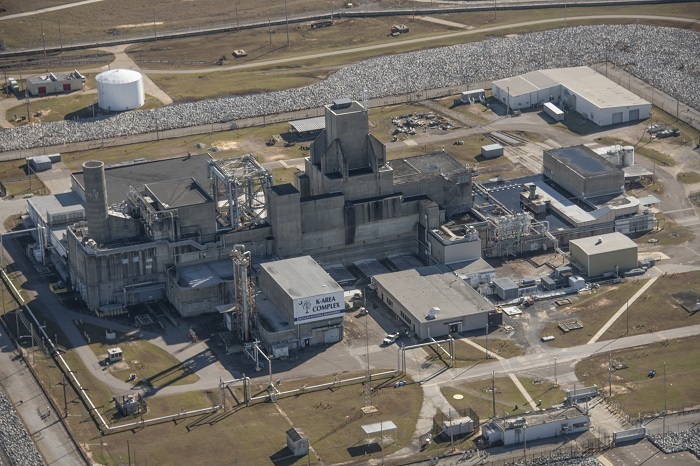 Crews at the K Area Complex at the Savannah River Site recently completed their 100th plutonium downblend for fiscal year 2023.
AIKEN, S.C. – EM crews at the Savannah River Site (SRS) recently completed their 100th plutonium downblend in fiscal year 2023 safely and ahead of schedule as part of ongoing work to remove the material from South Carolina.
“Reaching the 100th plutonium downblend well ahead of schedule is a huge accomplishment and a testament to our team’s commitment to remove plutonium from the state,” said K Area Deputy Facility Manager Maxwell Smith of Savannah River Nuclear Solutions (SRNS), the managing and operating contractor at SRS. “Much of our work in the past few years has been to introduce efficiencies and speed up our processing rates, and it’s gratifying to see the results of those efforts.”
Plutonium materials in K Area are sealed inside a robust configuration of storage and shipping containers until they are ready to be downblended. That process involves mixing the plutonium materials with an adulterant, producing a mixture that can eventually be safely disposed of at EM’s Waste Isolation Pilot Plant.
Downblending began in K Area in 2016 and was paused in 2019 to optimize equipment, training and personnel to expedite the process. That included installing new material entry and removal devices for the glovebox where downblending takes place; designing and fabricating special carts to move the downblend containers through the glovebox; and relocating equipment inside the glovebox to improve efficiency of the downblend process flow.
A stainless-steel containment enclosure about 15 feet long and 3 feet wide, the glovebox contains safety glass panels and fitted gloveports to allow radioactive materials handling, and isolates workers from associated hazards.
The K Area facility also moved from two- to four-shift operations and more than doubled the number of trained operators in the facility, so downblending could be done 24/7.
“SRNS has safely accomplished a great amount of work in an effort to increase downblending operations,” DOE-Savannah River Nuclear Materials Program Manager Bert Crapse said. “Because of their commitment, K Area went from completing nine downblends in fiscal year 2017 to completing over 100 in fiscal year 2023.”
Employees are set to begin processing plutonium material originally slated for fiscal year 2024 due to K Area reaching its downblending goal for fiscal year 2023 ahead of schedule, Smith said.
“Downblending supports DOE’s nonproliferation mission, and the K Area team is proud to be part of that mission,” he said.
Employees in K Area are installing three new gloveboxes and support systems, and constructing a HEPA electrical building and ventilation stacks as part of a project to help further increase downblending rates. That work is being done in conjunction with the National Nuclear Security Administration’s surplus plutonium disposition mission.
-Contributor: Lindsey MonBarren
 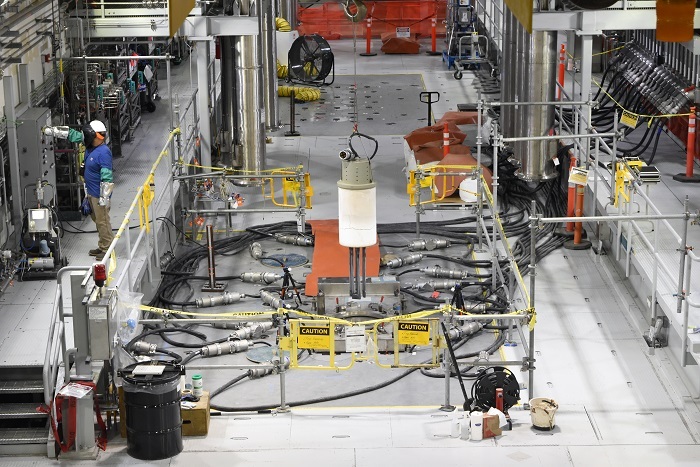
RICHLAND, Wash. – Workers at the Hanford Site Waste Treatment and Immobilization Plant (WTP) have begun removing the first three of 18 temporary startup heaters. The startup heaters were used to raise the first of two 300-ton glass melters in the Low-Activity Waste Facility to its operating temperature of 2,100-degrees Fahrenheit. Crews began removing the heaters after establishing a pool of molten glass in the melter using glass beads, or frit, and initiating Joule heating, which passes electrical current through the molten glass to produce heat. The crews replaced the startup heaters with bubblers, which circulate the molten glass using air to maintain a consistent mixture and temperature. The remaining startup heaters will be removed and replaced with bubblers after the final molten glass level is reached. During direct-feed low-activity waste operations, Hanford tank waste will be heated inside the WTP’s melters and mixed with glass-forming materials. The mixture will then be poured into stainless steel containers and allowed to cool before being disposed of in a specially engineered landfill on the Hanford Site called the Integrated Disposal Facility.
|